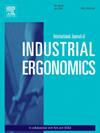The impact of Ergoprism and Through-the-Lens loupes on neck and back muscle fatigue
IF 2.5
2区 工程技术
Q2 ENGINEERING, INDUSTRIAL
International Journal of Industrial Ergonomics
Pub Date : 2025-03-12
DOI:10.1016/j.ergon.2025.103728
引用次数: 0
Abstract
Background
Work-related musculoskeletal disorders are a significant occupational health risk for dental professionals. Poor ergonomic practices, improper tools, and awkward positions have been identified as causative factors to such disorders.
Purpose
To investigate the impact of Ergoprism loupes (E loupes) and Through-the-Lens loupes (T loupes) on neck and back muscle activity in senior dental hygiene students.
Methods
Sixteen participants (age 24.38 ± 4.24yrs; BMI 25.37 ± 4.95 kgm−2; 1 left-handed; 16 females) were recruited for the study. Eight participants were E loupe users, and the other eight were T loupe users. Their bilateral splenius capitis (SC), upper trapezius (UT), and middle trapezius (UT)] activity was measured using electromyography (EMG) at 0 min, 15 min, and 30 min of a simulation task over two days that are 90 days apart.
Results
There was a significantly greater mean and peak muscle activity in the dominant SC and UT muscles among T loupe users at 30 min of the simulation task.
Conclusions
The results demonstrated greater neck and back muscle fatigue on the dominant side among T loupe users at 30 min of the simulation task compared to the E loupe users.
Application
The study findings are crucial in understanding the importance of acquiring ergonomic tools at the workplace. The study also illustrates the importance of frequent rest intervals in order to minimize muscle fatigue among dental hygienists. Such practices will lead to healthy workers, reducing the number of days of absence from work and improving their productivity.
Ergoprism和Through-the-Lens对颈背部肌肉疲劳的影响
背景:与工作相关的肌肉骨骼疾病是牙科专业人员的重要职业健康风险。不良的人体工程学操作,不适当的工具和尴尬的位置已被确定为导致这种疾病的因素。目的探讨角膜镜(E镜)和透镜(T镜)对口腔卫生专业高年级学生颈背部肌肉活动的影响。方法16例(年龄24.38±4.24岁;BMI 25.37±4.95 kgm−2;1左撇子;16名女性)被招募参加这项研究。8名参与者是E loupe用户,另外8名是T loupe用户。他们的双侧头脾(SC)、上斜方肌(UT)和中斜方肌(UT)的活动用肌电图(EMG)在模拟任务的0分钟、15分钟和30分钟进行测量,时间间隔为90天。结果在30分钟的模拟任务中,T loupe使用者中占优势的SC和UT肌肉的平均和峰值肌肉活动显著增加。结果表明,在模拟任务的30分钟内,T型背带使用者的颈部和背部肌肉的优势侧疲劳程度高于E型背带使用者。研究结果对于理解在工作场所获得符合人体工程学的工具的重要性至关重要。该研究还说明了经常休息的重要性,以尽量减少牙齿保健人员的肌肉疲劳。这些做法将使工人健康,减少缺勤天数,提高他们的生产力。
本文章由计算机程序翻译,如有差异,请以英文原文为准。
求助全文
约1分钟内获得全文
求助全文
来源期刊
CiteScore
6.40
自引率
12.90%
发文量
110
审稿时长
56 days
期刊介绍:
The journal publishes original contributions that add to our understanding of the role of humans in today systems and the interactions thereof with various system components. The journal typically covers the following areas: industrial and occupational ergonomics, design of systems, tools and equipment, human performance measurement and modeling, human productivity, humans in technologically complex systems, and safety. The focus of the articles includes basic theoretical advances, applications, case studies, new methodologies and procedures; and empirical studies.

 求助内容:
求助内容: 应助结果提醒方式:
应助结果提醒方式:


